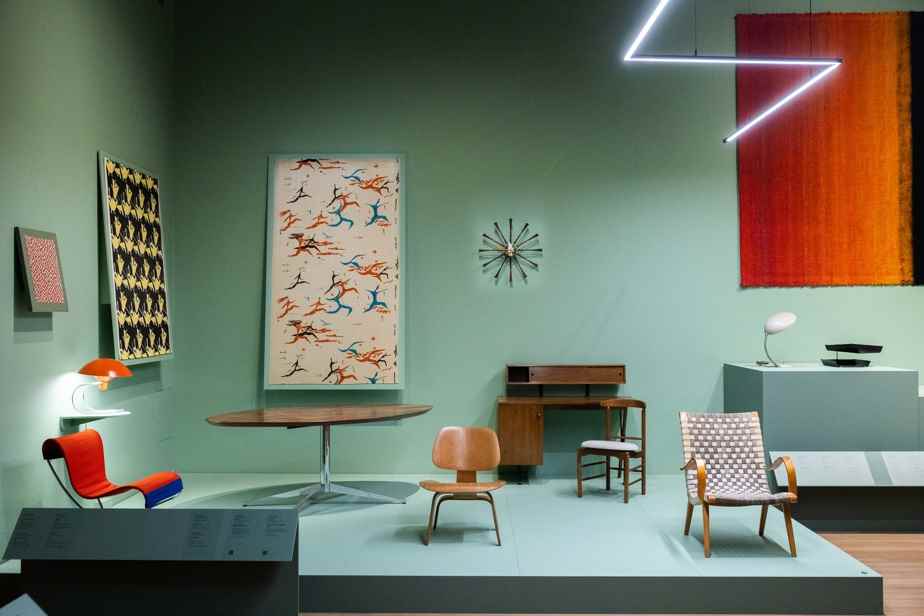The plywood and molded wooden chair LCW by Ray and Charles Eames, which appeared after the Second World War, still makes design lovers green with envy, to the point of recently encouraging the Danish brand HAY to join forces with its historic manufacturer Herman Miller for a reissue in a vibrant color palette. This piece of furniture with organic shapes, which is one of the iconic objects of the XXe century, is the result of the creative exchanges of the mythical Californian couple. And yet, only the genius of Charles has long been hailed by his peers and the media, the designer being considered only as his spouse or, at best, his assistant. Post-war society had a tendency to live with the cliché of the housewife.
Architect and designer Greta Magnusson-Grossman will see herself confronted with ordinary misogyny in her native Sweden before finding success in Los Angeles, where she will put her talent at the service of Greta Garbo, Ingrid Bergman and Frank Sinatra. His lamp Cobra and his Office 62 (whose production was relaunched by the Danish brand Gubi some ten years ago) took their place alongside some 250 works and objects by Quebec, Canadian and American designers from the mid-19e century to the present day for the exhibition Parall(elles), another design story, at the Montreal Museum of Fine Arts (MMFA). A large-scale program born under the impetus of the “Women of Design” project of the Stewart Program for Modern Design which presents the joint collections of the two institutions through the female lens on a new online platform.
-

PHOTO MARTIN TREMBLAY, THE PRESS
In the foreground, work in linen and wool Banisteriopsis by renowned American textile artist Sheila Hicks
-

PHOTO MARTIN TREMBLAY, THE PRESS
Behind a metal and glass desk with lines inspired by the Bauhaus by Montrealer Jeannette Meunier Biéler stand out the tapestry Eden by Marguerite Thompson Zorich and a rug by Loja and Eleil Saarinen.
-

PHOTO MARTIN TREMBLAY, THE PRESS
Ceramic vases dating from the 1960s
-

PHOTO MARTIN TREMBLAY, THE PRESS
There Zulu Renaissance Writing Table for a Lady by Cheryl R. Riley is reminiscent of the cabinets of curiosities of yesteryear.
-

PHOTO MARTIN TREMBLAY, THE PRESS
View of the Corvette Fancy Free designed in the 1950s by Ruth Glennie for General Motors, as well as on the wool tapestry burst of joy by Quebec artist Mariette Rousseau-Vermette
-

PHOTO MARTIN TREMBLAY, THE PRESS
The quilt Tar Beach 2by Faith Ringgold, recounts her life as a little girl in Harlem.
1/6
At hand
“This exhibition reveals the crucial role that these designers, whose contribution has been minimized, even obliterated from the historical narrative, have played in the history of design. By emphasizing the gendered nature of the practices, it allows us to understand the way in which certain prejudices have influenced feminine design”, explains Jennifer Laurent, curator of decorative arts and design, and curator of the exhibition which , moreover, directed the work that accompanies this exhibition.
To carry out this undertaking, the MMFA has chosen to extend the definition of design to creation and, in particular, to craftsmanship (pottery, embroidery, weaving, silversmithing, jewellery, etc.), a field of expertise traditionally more accessible to women than that of industrial design, where the object is reproduced in series.
The visit follows the passage of time, from the heyday of the Arts and Crafts movement, which came from Great Britain at the end of the 19e century, inviting everyone to reconnect with nature through manual gestures, the blending of modern influences and aspirations. The halls mirror bold initiatives often driven by unfailing perseverance for women who have long been deprived of access to artistic training, with the exception of those given by a father, husband or lover.
“Despite the social restrictions of their time, women have found a way to create, and this work has improved their lives and those around them,” says Jeannine Falino. The American decorative arts consultant supported the MMFA in the preparation of this exhibition, which includes several very fine works by artists from the First Nations and African-American communities, as well as pieces from private collections and some thirty Canadian museums and Americans.
Borrowings and imprints
This slow creative journey, in the wake of men, has never ceased to nourish collective inspiration. Moreover, today industrial design increasingly incorporates the imperfection of handwork, in which women have distinguished themselves, in its production. Here, by means of the roughness of a ceramic, there, by assemblages of fabrics or prints similar to those that can be found on traditional quilts for a sensitive result with a more human dimension. This makes the separation between design and craftsmanship all the more porous and the bias of the MMFA relevant. Her initiative is part of a desire to support the work of women artists over the long term. “This exhibition is a way of drawing attention to the great achievements of women and the need to pursue this recognition,” observes Jeannine Falino. Although we have made great progress over the past 50 years, it is difficult for a society to shed its prejudices. »
At the Montreal Museum of Fine Arts, until May 28, 2023
